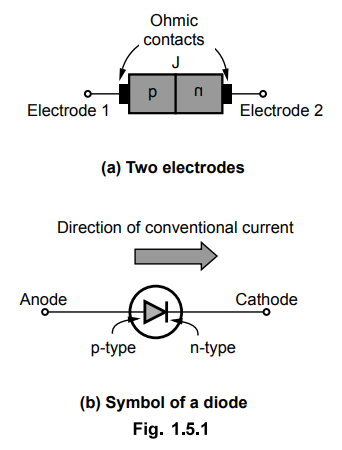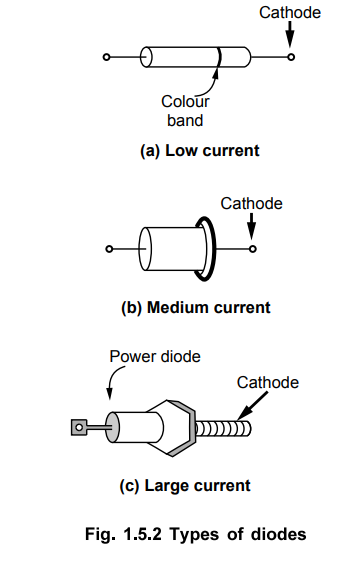Electron Devices and Circuits: Unit I: PN Junction Devices
The P-N Junction Diode
Symbol, Biasing, Types
• The p-n junction forms a popular semiconductor device called p-n junction diode. The p-n junction has two terminals called electrodes, one each from p-region and n-region. Due to the two electrodes it is called diode i.e. di + electrode.
The P-N Junction Diode
•
The p-n junction forms a popular semiconductor device called p-n junction
diode. The p-n junction has two terminals called electrodes, one each from
p-region and n-region. Due to the two electrodes it is called diode i.e. di +
electrode.
•
To connect the n and p-regions to the external terminals, a metal is applied to
the heavily doped n and p-type semiconductor regions. Such a contact between a
metal and a heavily doped semiconductor is called ohmic contact. Such an ohmic
contact has two important properties,
1.
It conducts current equally in both the directions.
2.
The drop across the contact is very small, which do not affect the performance
of the device.
•
Thus ohmic contacts are used to connect n and p-type regions to the electrodes.
•
The Fig. 1.5.1 (a) shows schematic arrangement of p-n junction diode while the
Fig. 1.5.1 (b) shows the symbol of p-n junction diode. The p-region acts as
anode while the n-region acts as cathode. The arrowhead in the symbol indicates
the direction of the conventional current, which can flow when an external
voltage is connected in a specific manner across the diode.

1. Biasing of P-N Junction Diode
•
Applying external d.c. voltage to any electronic device is called biasing, As
seen, there is no current in the unbiased p-n junction at equilibrium.
Key
Point : The usefulness of p-n junction lies in the fact
that it allows current flow only in one direction, under biased condition.
•
Depending upon the polarity of the d.c. voltage externally applied to it, the
biasing is classified as Forward biasing and Reverse biasing.
2. Types of Diodes
•
When forward current flows under forward biasing, diode gets heated. Hence
forward current should not exceed the particular maximum value. Similarly the
diode can be damaged due to large reverse voltage applied to it during reverse
biasing. This voltage also must be maintained below the particular maximum
value. These maximum values are specified in the manufacturer's datasheet.
Key
Point : Practically the diodes which can carry large
forward current and handle large reverse voltage are physically large in size.
•
The diodes which are small in size can carry low forward current and can handle
low reverse voltage. The Fig. 1.5.2 shows the types of diodes based on forward
current carrying and reverse voltage withstanding capacity.


• Let us see in detail, behaviour of a p-n
junction under two biasing conditions.
Review Question
1. What is p-n junction diode ? What is biasing of diode ?
Electron Devices and Circuits: Unit I: PN Junction Devices : Tag: : Symbol, Biasing, Types - The P-N Junction Diode
Related Topics
Related Subjects
Electron Devices and Circuits
EC3301 3rd Semester EEE Dept | 2021 Regulation | 3rd Semester EEE Dept 2021 Regulation
